In this Monserrat neighbourhood guide, we’ll share the best things to do, where to eat, where to shop and where to stay so you can navigate this iconic Buenos Aires neighbourhood.
About Monserrat Buenos Aires
Monserrat is one of the oldest neighbourhoods in Buenos Aires and its origins can be traced back to the city’s second founding in 1580.
That’s right, Buenos Aires was founded and destroyed multiple times! It was first founded in 1536, then destroyed in 1541, and founded again in 1580 when Juan de Garay disembarked on the shores of Río de la Plata.
This means there’s a lot of history to uncover in Monserrat and many of Buenos Aires’ main attractions can be found in this very neighbourhood!
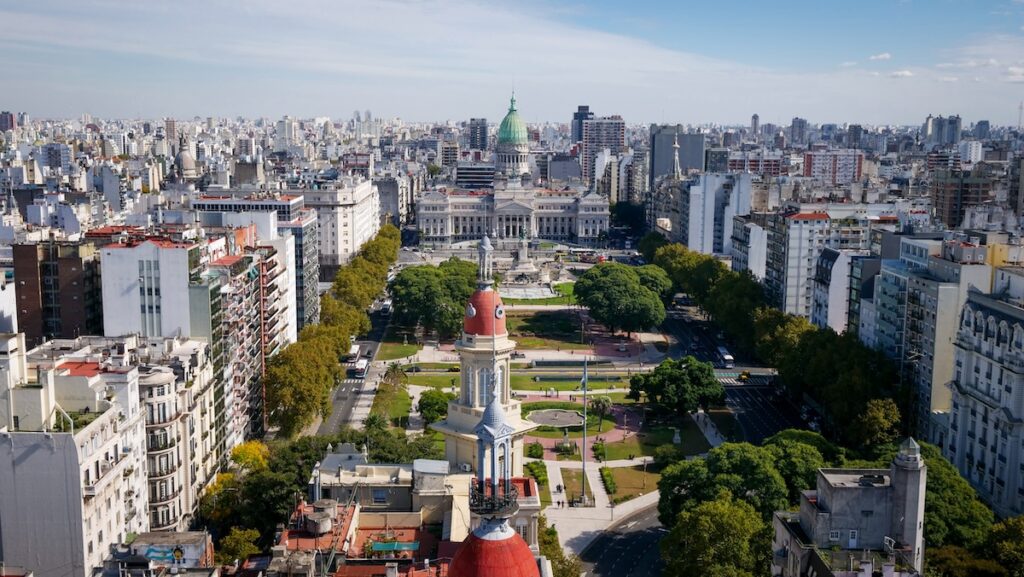
Monserrat Neighbourhood Guide
Monserrat, sometimes also written as Montserrat, is flanked by the neighbourhoods of Puerto Madero to the east, San Telmo and Constitucion to the south, Balvanera to the west, and San Nicolas to the north.
This Buenos Aires neighbourhood got its name in 1769 after the construction of the Parish of Our Lady of Monserrat.
In this Monserrat neighbourhood guide, we’re going to cover some of the various tours, sights and attractions that you can enjoy in the area.
Things to do in Monserrat, Buenos Aires

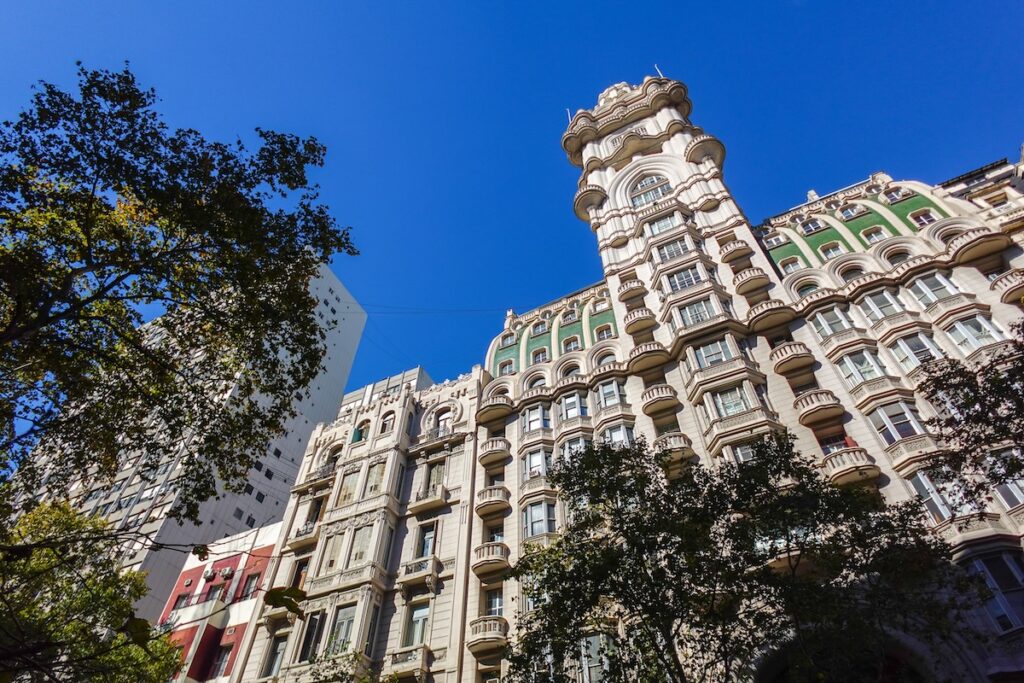
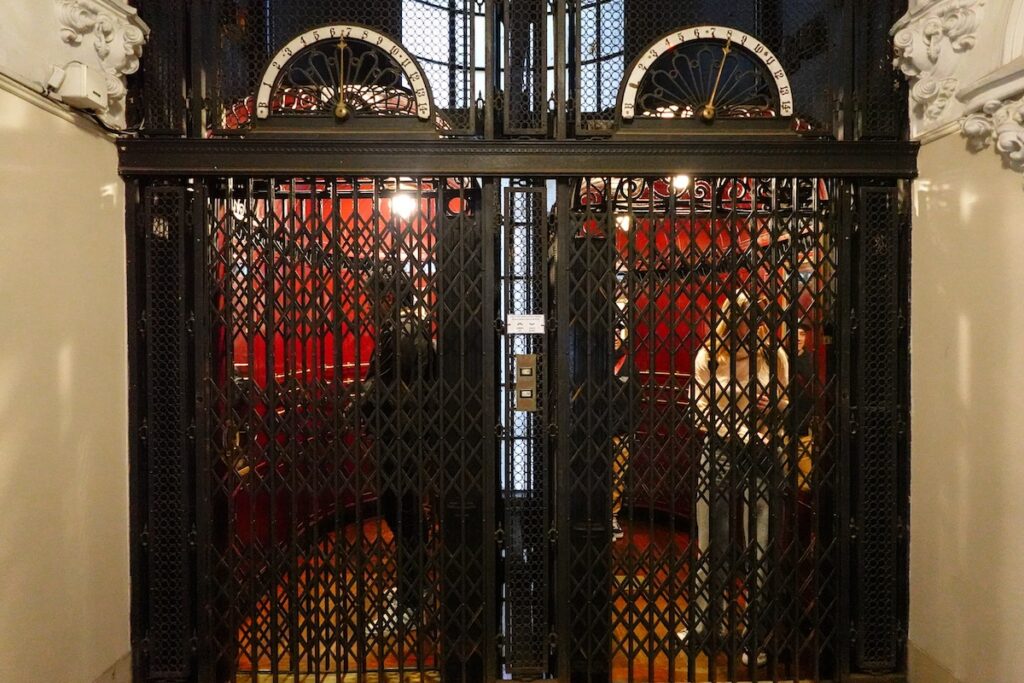
1. Palacio Barolo
Palacio Barolo is one of Buenos Aires’ most iconic and architecturally fascinating buildings. It was the tallest building in South America upon its completion in 1923 and remains a prominent landmark in the city’s skyline.
Located on Avenida de Mayo, this skyscraper blends neo-Gothic and Art Nouveau styles with symbolic elements inspired by Dante Alighieri’s Divine Comedy.
This is an attraction that I had walked past countless times, but I finally decided to take the guided tour during my most recent visit to Buenos Aires. I mean, sure the building is beautiful from the outside, but you need to see it from the inside to understand its connection to Dante’s Divine Comedy.
The construction of Palacio Barolo was commissioned by Luis Barolo, an Italian immigrant and wealthy businessman, as a testament to his admiration for Dante. He in turn hired Mario Palanti, an Italian architect to bring his vision to life.
The building is divided into three distinct sections that correspond to the three parts of the poem: Hell, Purgatory, and Heaven. The basement and ground floor represent Hell, the middle floors symbolize Purgatory, and the top floors, crowned by a lighthouse, signify Heaven.
We enjoyed doing the Palacio Barolo guided tour, not just for the architecture but also for the views you get from the palace.
At first, we were a bit concerned about how demanding it would be – elevators take you to a certain point, but the final ascent requires climbing 160 steps! Also, the narrowest point of the staircase is 48 centimetres or 18 inches wide, so it does feel like a bit of a squeeze!
However, the reward is getting to see an iconic postcard view of the National Congress of Argentina, plus other famous landmarks. If you happen to visit on a clear day, you can even see as far as Uruguay across the Río de la Plata.
2. Tango Show at La Ventana
Another activity that couldn’t be missing in this Monserrat neighbourhood guide is attending a tango show!
Tango is a dance that originated in the 1880s along the River Plate in both Buenos Aires and Montevideo. It was considered a very risqué dance at the time and something that was only seen in the working-class slums that housed many of the newly arrived European immigrants.
La Ventana Barrio de Tango is one of the more popular tango venues in the neighbourhood. It is set in a former conventillo, also known as a tenement which has been completely restored.
The nice thing about this particular show is that it combines a live tango orchestra and an Argentine gaucho band. That means that aside from watching dancers grace the stage to dance tango, you can also watch a more traditional folklore dance.
When it comes to booking this experience, you can opt for just the show or the dinner and show. The dinner is a 3-course meal featuring an entree, main dish and dessert.
💃 This tango show at La Ventana gives you the option of booking a 3-course dinner or attending the show only.
This list of the top tango shows in Buenos Aires may also be of interest.
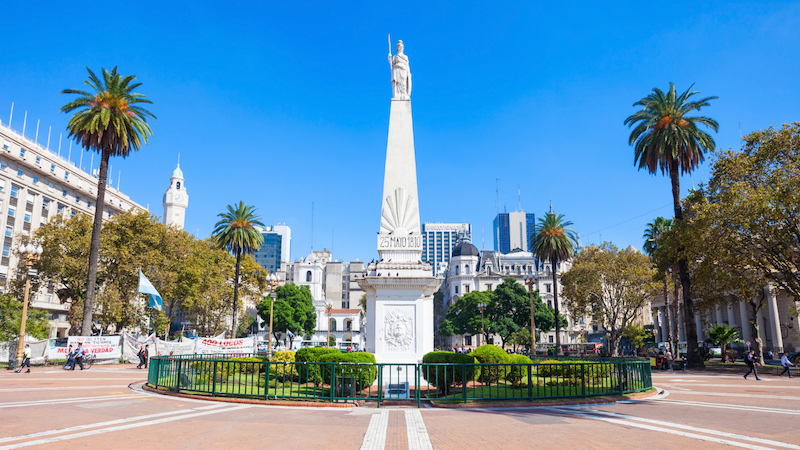
3. Plaza de Mayo
Plaza de Mayo is one of Argentina’s most historically significant squares. It was established in 1580 and has been at the epicentre of political and social life for over four centuries – that means protests, revolutions, and celebrations!
The square is named after the May Revolution of 1810, which marked the beginning of Argentina’s path to independence from Spain.
In the centre of the square, you’ll find the May Pyramid or Pirámide de Mayo, which was erected in 1811. This obelisk commemorates the first anniversary of the May Revolution and it’s the oldest national monument in Buenos Aires.
Plaza de Mayo is surrounded by numerous attractions, so it’s a good place to begin your tour of Buenos Aires.
If you time your visit just right, you can catch the Changing of the Guard. You’ll get to see the grenadiers march from Casa Rosada to the Cathedral, where they’ll relieve the guard at the mausoleum of General Don José de San Martín. The changing of the guard takes place from 7:00 am to 5:00 pm every 2 hours.
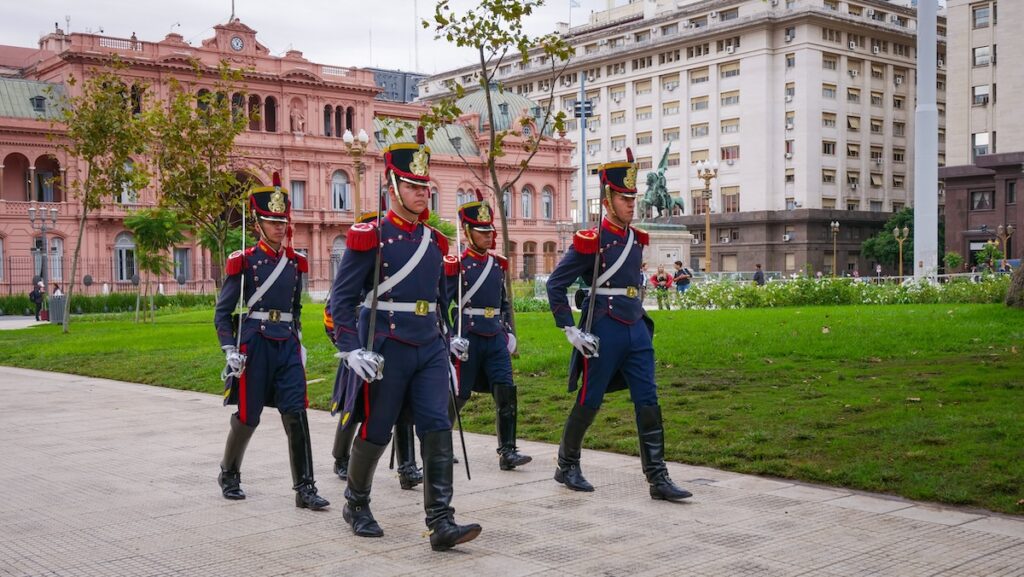
4. Casa Rosada
Casa Rosada, or the Pink House, is the executive mansion and office of the President of Argentina. Also known as the Government House or Casa de Gobierno, this building sits on the east end of the Plaza de Mayo.
The Casa Rosada is known for its Italianate architecture and unique pink colour. “Why pink?”, you might ask.
Well, the building’s hue is said to be a combination of red and white, representing the colours of the opposing political factions in 19th-century Argentina; the Federals used red while the Unitarians used white.
Another explanation you might hear is that at one point the Pink House was painted with cows’ blood, a supposed alternative to paint that wouldn’t peel in the humidity!
The interior of the Casa Rosada is just as impressive, featuring grand halls, beautiful staircases, and historic rooms like the Salón de los Bustos, where busts of former presidents are displayed.
The building also has a stunning courtyard known as the Patio de las Palmeras, filled with palm trees and statues.
Note: Casa Rosada is not currently open to visitors (only guided school visits). When it does re-open to the general public, you’ll be able to click through Visitas Casa Rosada. They typically offer free guided tours in both English and Spanish. You will need your passport to enter.
5. Museo Casa Rosada
Museo Casa Rosada, or the Pink House Museum, is located underneath the presidential palace. In fact, it is set in the same place where the original fort of Buenos Aires and later the Taylor Customs Office once stood.
Visiting this museum feels like taking a step back in time because the old foundations that lay hidden underneath Casa Rosada had to be excavated in order to create this place.
The museum essentially sits underground and features original exposed brick walls, vaulted galleries, and a glass ceiling that lets in lots of natural light.
Museo Casa Rosada covers some 200 years of history since the May Revolution of 1810 to the present day focusing on Argentina’s presidential history.
The exhibits feature artifacts that would have belonged to former presidents, including official documents, presidential sashes, medals, portraits, cars, and carriages.
We ended up visiting this museum as a fun rainy day activity in Buenos Aires. After walking past the Casa Rosada so many times during almost every visit to Buenos Aires, it was a pleasant surprise to go into the museum and learn a bit more about the country’s early history.
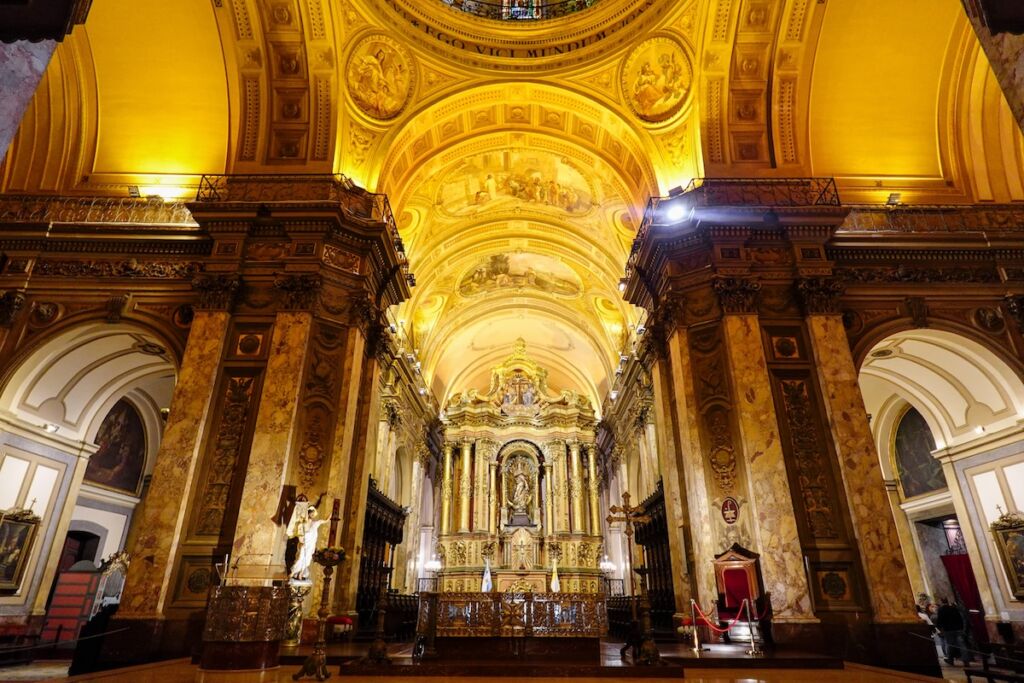
6. Buenos Aires Metropolitan Cathedral
The Buenos Aires Metropolitan Cathedral is the main seat of the Catholic Church in Argentina and the seat of the Archbishop of Buenos Aires.
Located on the northwest end of Plaza de Mayo, this grand cathedral is a cornerstone of the city’s religious and historical heritage.
The cathedral’s origins date back to the late 16th century, shortly after the founding of Buenos Aires. It underwent several reconstructions due to damage and architectural changes, with its current neoclassical facade completed in the mid-19th century.
The cathedral’s design reflects a mix of architectural styles. The facade, designed by French architects Próspero Catelin and Pierre Benoit, features a neoclassical portico with twelve columns representing the apostles. The interior, however, retains its colonial-Baroque roots with a series of ornate chapels and a tiled floor inspired by the Vatican’s Sistine Chapel!
The cathedral houses the mausoleum of General José de San Martín, the revered liberator of Argentina, Chile, and Peru. His tomb is guarded by statues representing the countries he helped liberate, and it’s a site of great national pride and reverence.
The cathedral gained international attention when Jorge Mario Bergoglio, the Archbishop of Buenos Aires, became Pope Francis in 2013. He served as the archbishop here for many years.

7. Cabildo
Officially known as the Museo Histórico Nacional del Cabildo y la Revolución de Mayo, the Cabildo is a historic museum on the west end of Plaza de Mayo.
The building served as the seat of the town council during Spanish colonial rule and it was here that the first steps toward Argentine independence were taken.
The Cabildo played a pivotal role during the May Revolution, where meetings and deliberations were held that ultimately led to the establishment of the first Argentine government independent of Spain.
This museum is free to visit and its collection includes original documents, paintings, and artifacts that range from the colonial period to the early 19th century. These exhibits key in on the social, political, and cultural life of Buenos Aires during the transition from a Spanish colony to an independent nation.
Visitors can explore items related to the May Revolution, such as weapons, uniforms, and personal belongings of revolutionary leaders.
The building is an important example of colonial architecture in Buenos Aires featuring white walls, arched galleries, and a distinctive bell tower. Although it has undergone several modifications, it still retains much of its original 18th-century charm.
The Cabildo is a National Historic Monument and it’s well worth a visit if you find yourself in the area.

8. National Congress of Argentina
The National Congress of Argentina, or Congreso de la Nación Argentina, is the legislative branch of the Argentine government.
This imposing neoclassical building is a symbol of the country’s democratic processes and political history. It serves as the meeting place for the two chambers of Congress: the Senate and the Chamber of Deputies.
The building was designed by architect Víctor Meano and inaugurated in 1906. Its style is inspired by classical Greek and Roman architecture featuring grand columns, a massive dome, and intricate marble interiors.
The dome, which stands over 80 meters high, is one of the most recognizable features of Buenos Aires’ skyline and is topped by a bronze sculpture symbolizing the Republic.
The interior of the Congress building is adorned with marble staircases, stained glass windows, and ornate sculptures.
The National Congress offers free guided tours that provide insight into the history, architecture, and legislative process. You’ll need to bring your passport in order to enter.
9. Block of Enlightenment
The Block of Enlightenment, or Manzana de las Luces in Spanish, is one of Buenos Aires’ most historically and culturally significant areas.
Located in the Monserrat neighbourhood just one block diagonally southwest from Plaza de Mayo, this area is known for its history as an education hub during the colonial and early post-colonial periods.
The block dates back to the 17th century and was originally the site of several important institutions, including the Jesuit Church, the first university of Buenos Aires, the country’s first printing press and newspaper, and a series of educational and religious buildings. This was a center for learning and intellectual development which is how it earned its name as the Block of Enlightenment.
One of the most intriguing aspects of Manzana de las Luces is its network of underground tunnels. These tunnels, built by the Jesuits in the 18th century, were used for various purposes, including defence and escape routes. Visitors can explore parts of this labyrinth, which adds an element of mystery to the historical site!
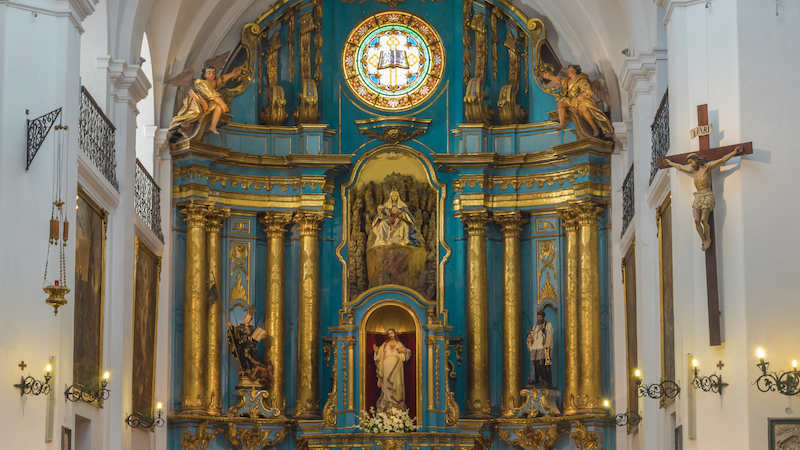
10. San Ignacio de Loyola
San Ignacio de Loyola, or Saint Ignatius Church, forms part of the Block of Enlightenment and it’s the oldest existing church in Buenos Aires!
This is a church that was built very gradually with numerous additions. The very first church was built by the Society of Jesus in 1675 and it was made of adobe.
Then came the addition of the present facade and the southern tower in 1686. The rest of the church’s construction was completed between 1712 and 1722, finally ending with its consecration in 1734.
They offer guided visits to the cloisters, Jesuit tunnels and the towers, though you need to purchase your ticket in advance.

11. Tomb of Manuel Belgrano at Santo Domingo Convent
The Tomb of Manuel Belgrano is located at the Convento de Santo Domingo, a historic convent and church in Monserrat, Buenos Aires.
This site is significant not only for its religious heritage but also as the final resting place of one of Argentina’s most revered national heroes, Manuel Belgrano, the creator of the Argentine flag and a key figure in the country’s struggle for independence.
Belgrano was a prominent military leader, lawyer, and economist who played a crucial role in Argentina’s independence movement. He is best known for leading the Northern Army during the Argentine War of Independence and for designing the national flag in 1812.
The convent, built in the late 18th century, was a central location during the British invasions of the Río de la Plata in 1806 and 1807. It sustained significant damage during the invasions, but it was restored and has since become a symbol of resilience and national pride.
The tomb, located outside the main entrance of the convent, was constructed in 1903 to honour Belgrano’s legacy. It features a marble mausoleum designed by the Italian sculptor Ettore Ximenes. The monument is adorned with symbolic reliefs and sculptures representing Belgrano’s contributions to the nation.
Where to Shop in Monserrat
Aux Charpentiers
Aux Charpentiers is a historic supply store in Buenos Aires that dates back to 1888. They sell traditional Argentine work clothes, riding clothes and gaucho clothes.
If you’re looking to pick up some traditional clothing items like bombachas (gaucho pants) or boinas (gaucho hats), this would be the place to visit!
I happen to think that boinas make for a great traditional Argentine souvenir – there are so many styles and colours to choose from and some are even embroidered, so you can find some truly unique pieces.
Seeing as this is an older and more traditional store, shopping here is a little bit different as everything is on display behind the counter. It’s good to have an idea of the item you’re looking for, and then you can ask the shop assistant for help when it comes to pulling different colours and sizes.
Yes, this is very different from shopping in North America, where you grab the item you want, pay for it and go. Things are a bit more involved here and take more time, but you’ll also get the help you need to find a piece that fits just right.
Address: México 1302, Monserrat, Buenos Aires
Librería Ávila (Librería del Colegio)
Another cool shop to visit in Monserrat is Librería Ávila, a bookstore that dates back to 1785 making it the oldest in the city of Buenos Aires!
Librería Avila is also known by its former name, Librería del Colegio since for several decades it supplied books to the local students across the street at Real Colegio de San Carlos and later Colegio Nacional de Buenos Aires.
This bookstore also played an important role in the May Revolution of 1810 which ultimately gave Argentina its freedom from Spain. It was here that future leaders gathered looking for newly arrived books from France with thoughts and ideas about the French Revolution.
At Libreria Ávila you can peruse both new and used books, however, they specialize in out-of-print and rare books. So if you’re searching for something in particular, chat with the staff as they’re a wealth of knowledge.
Address: Adolfo Alsina 500, Monserrat, Buenos Aires
Where to Eat in Monserrat
Bar El Colonial
One of the many things I love about Buenos Aires are its bares notables. These are historic bars, billiard clubs or cafeterias that are somehow related to significant cultural events or activities that took place in the city and are recognized as a Cultural Heritage of the City of Buenos Aires.
Bar El Colonial is one such establishment. Part of this building dates back to the colonial era with kiln-dried mud and straw bricks. The cafe is located just one block from the Block of Enlightenment and directly across from the iconic Otto Wolf Building.
This is the type of place you’d come to have a cafe con leche with a side of medialunas for breakfast.
They’re also well known for their salami or jamón crudo sandwiches if you’re looking for a quick and easy lunch.
Like most Buenos Aires cafes, it’s a fun spot for people-watching!
Address: Avenida Belgrano 599, Monserrat, Buenos Aires
D’Oro Italian Bar
D’Oro Italian Bar is an Italian restaurant and wine bar specializing in all things pasta!
To be honest, everything on their menu sounds absolutely mouthwatering: spaghetti with pesto and brie, sweet potato gnocchi with mushrooms in an orange cream sauce, and ravioli stuffed with beef tenderloin in a Malbec sauce!
Plus, they also have risotto, meat and seafood dishes like any good Italian restaurant does.
Their dessert menu features classics like tiramisu, panna cotta with pistachios and a chocolate volcano cake with mascarpone.
Address: Perú 159, Monserrat, Buenos Aires
Furaibo
Furaibo is a Japanese restaurant and it’s also one of the top-rated foodie establishments in Monserrat.
Their menu is quite varied featuring ramen, sushi, tonkatsu, yakisoba and so much more.
You can order a la carte or they also have an assortment of tasting menus where you can sample a bit of everything.
If you’ve been in Argentina for a while and are craving some international flavours, this is a fun option!
Address: Adolfo Alsina 429, Monserrat, Buenos Aires
Dome Roof Top Bar
For cocktails with a sunset view of Buenos Aires, you can’t go wrong with Dome Roof Top Bar. This bar is located in the sixth floor of the Tango de Mayo Hotel overlooking Avenida de Mayo.
This is considered one of the best rooftops in Buenos Aires thanks to the city views of Palacio Barolo as well as numerous domes and Parisian-style architecture.
Their cocktail menu features lots of Argentine favourites like fernet con coca, cinzano con soda, and wiscola. Plus, they also have a decent selection of red, white and sparkling wines.
As for food, their menu is tapas style featuring lots of appetizers, charcuterie boards and finger food perfect for sharing.
Address: Avenida de Mayo 1396, Monserrat, Buenos Aires
Where to Stay in Monserrat
This Monserrat neighbourhood guide wouldn’t be complete without sharing a few accommodation options. Here’s a handpicked selection including a boutique hotel, an art hotel and a lively hostel – all set in beautiful historic buildings.
Tango de Mayo Hotel
Tango de Mayo Hotel is located in Buenos Aires’ Monserrat neighbourhood overlooking Avenida de Mayo. It’s set in a historic building that dates back to the 1910s and features many Art Nouveau-inspired details.
The hotel offers a daily buffet-style breakfast with pastries, bread, fruit, eggs, sausages, deli meats and cheeses.
The rooms offer floor-to-ceiling windows with beautiful city views, free WiFi access and a private bathroom with toiletries.
Address: Avenida de Mayo 1396, Monserrat, Buenos Aires
Stay at Tango de Mayo Hotel.
Cassa Lepage Art Hotel
Cassa Lepage Art Hotel sits in the heart of the Monserrat neighbourhood and is a stone’s throw from many iconic Buenos Aires landmarks.
The hotel features a total of 22 rooms in various layouts: classic suite, superior suite, master suite and grand master triple.
As an art hotel, plenty of art adorns this establishment, plus they have a gallery that regularly features the works of contemporary Argentine artists.
Another reason to consider staying at Cassa Lepage Art Hotel is that they have their very own museum. This is one of Monserrat’s historic buildings and when the hotel underwent a renovation back in 2005, archaeological excavations discovered a whole network of underground structures with hundreds of objects dating from the early 17th century!
Address: Pasaje Belgrano, Bolívar 373, Monserrat, Buenos Aires
Stay at Cassa Lepage Art Hotel.
Milhouse Avenue Hostel
If you’re looking for a youthful and lively atmosphere, you’ll find that at the Milhouse Avenue Hostel.
This Monserrat hostel is set in a refurbished house that dates from the 19th century.
They offer an assortment of room types to suit all types of travellers – single, twin, double, triple, and quadruple rooms all with private bath. For a more budget-friendly option, they also have mixed and female dorms with shared bathrooms.
There are lots of common spaces to hang out and meet other travellers like the bar where you can order snacks and drinks, a kitchen where you can prep your own meals, and the terrace where you can barbecue.
Address: Avenida de Mayo 1245, Monserrat, Buenos Aires
Stay at Milhouse Avenue Hostel.
Other Neighbourhoods in Buenos Aires
Now that you know what to expect from Monserrat, you can decide if it’s the right neighbourhood for you. If you’re looking for something a bit different, you may want to consider some of the following neighbourhoods:
San Telmo – Think cobblestones, antique shops, and tango echoing through the streets. This is old-school Buenos Aires and it’s ideal for history lovers, vintage treasure hunters, and anyone who swoons over a bit of bohemian charm.
Recoleta – Elegant, leafy, and a little bit Parisian, Recoleta is where Buenos Aires shows off its refined side. Think Belle Époque mansions, grand avenues, world-class museums, one of the most beautiful cemeteries in the world, and café terraces made for lingering. We cover everything to see, eat and do in this Recoleta neighbourhood guide.
Puerto Madero – All glass towers and glossy boardwalks, Puerto Madero is BA’s sleek, modern face. Come here for riverside strolls, fancy dinners, and a polished vibe that feels a world away from the city’s hustle.
Retiro – Grand architecture meets urban energy. Retiro is a stylish launch pad, perfect for travellers who want to be close to everything while soaking up a touch of old-world elegance.
Palermo – Trendy cafés, leafy parks and buzzing nightlife. Palermo is the cool kid of Buenos Aires. It’s made for foodies, creatives, and anyone who loves hopping from brunch to boutique to bar without skipping a beat.
La Boca – Bursting with colour, music, and fútbol passion, La Boca is pure personality. I always say this is a better place to visit in the daytime than to stay overnight, as it can be a little rough if you wander a couple of blocks in the wrong direction.
Chacarita – A little under the radar but full of character, Chacarita is where the creative crowd hangs out. Think craft beer, cool cafés, and local life at a slower pace. Great if you love discovering places before they’re cool.
Villa Crespo – This is Palermo’s effortlessly cool neighbour, a little less polished and more authentic. It’s for travellers who love a good hidden gem, whether that’s a tucked-away bakery, vintage shop, or hole-in-the-wall restaurant.
GROUP TOURS – If you’d rather join a group tour to travel in Argentina, check out Gadventures.
CAR RENTAL – To explore Argentina beyond the cities, the best way to do so is by renting a car. Discover Cars offers rentals across the country.
BUS TICKETS – Bus travel is a great way to see Argentina. BusBud offers numerous routes.
TRAVEL INSURANCE – Don’t leave on your trip without booking travel insurance. You can get a quote on SafetyWing.
HOTELS – Booking.com offers accommodations to suit all budgets and travel styles.
TOURS – For a variety of tours and activities, have a look at Viator.
